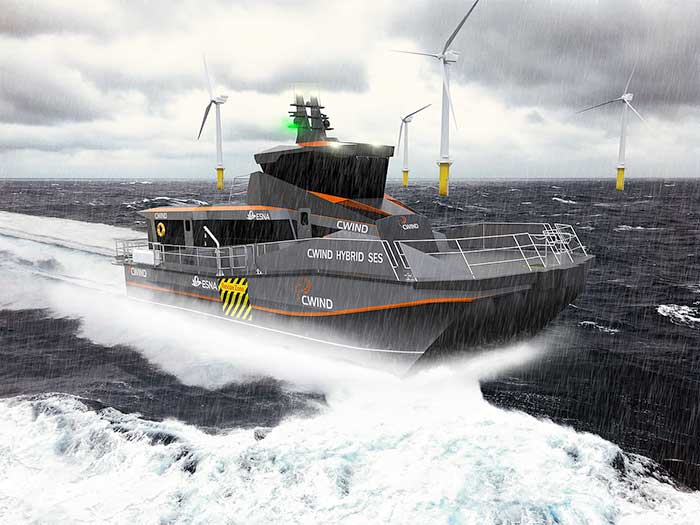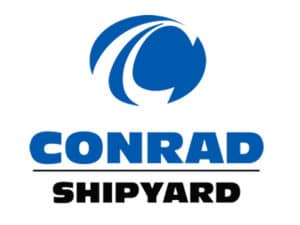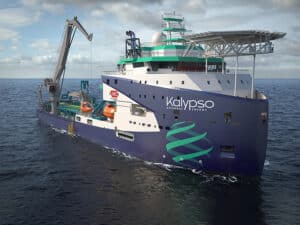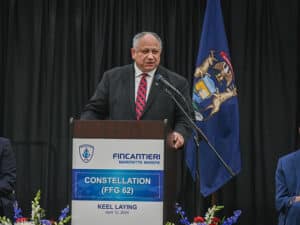
Wight Shipyard calls hybrid SES crew transfer vessel a “game changer”
Written by Nick Blenkey
Vessel will be able to handle 2 m significant wave height during technician transfer in heavy seas
Britain’s Wight Shipyard Co. has released some more details of the first-of-its-kind hybrid surface effect crew transfer vessel that it is to build for offshore wind support specialist CWind.
The SES will service Ørsted’s Borssele 1 and 2 offshore wind farms located 23 km off the Dutch coast.
Wight Shipyard will manage the build project from its development stage right through to delivery. It says that the vessel will be a game changer for the industry because of its ability to handle 2 m significant wave height during technician transfer in heavy seas. At the same time, it will decrease fuel consumption and CO2 emissions.
The hybrid SES propulsion engine will deliver sprint speed and extreme bollard push from its 1,600 kW installed diesel engines, which can be battery boosted up to 1,500 kW. Significant fuel savings will be achieved through balancing engine and inefficient low engine power running hours, with battery drive modes including wind farm standby and low speed/harbor operations. This will lead to an engine operating hour reduction of 50% during windfarm battery standby.
The vessel was developed in partnership with the operator CWind and ESNA, a ship design company based in Kristiansand, Norway, that specializes in commercially competitive vessels with surface effect technology to deliver significant carbon reductions.
The area between the vessel’s two catamaran hulls is closed by flexible reinforced rubber fingers in the bow and an inflated rubber bag in the stern. Centrifugal fans blow air into this enclosed space, providing an air cushion that supports up to 80% of the vessel weight. The remaining 20% is supported by hull buoyancy. This allows for higher vessel speed because the hull resistance is significantly decreased. It also reduces motion owing to less wave contact. In addition, the air cushion acts as a large shock absorber, improving the seakeeping and reducing seasickness.
The overall design and build, with 24 passenger capacity, will pay particular attention to technician and crew health, safety and comfort, thus delivering the workforce in the best possible work-ready condition.
Naval architect and co-founder of ESNA, Trygve H. Espeland, said “The vessel design will accommodate further developments in hybrid propulsion and battery technology, ensuring it has the capability of being developed into a totally carbon-free solution in the future. Wight Shipyard Co was the obvious partner for the build because of its solid reputation for both quality timely builds and experience bringing a new concept hybrid vessel to market”.
Charter agreement
CWind’s long-term charter contract agreement with Ørsted, which operates the Borssele 1 and 2 offshore windfarms, will start in mid-2020. The agreement will cover an initial three-year firm charter with options available for a further two years.
The new CWind Hybrid SES will enable Ørsted to not only deliver and service windfarms efficiently through reduced transit times, but support Ørsted’s green energy ambition. The Hybrid SES crew transfer vessel will operate from the Dutch port of Vlissingen to Borssele 1 and 2, located 23km from the Dutch coast in the North Sea.
Principal particulars
- Builder: Wight Shipyard Co
- Designer: ESNA
- Length Overall: 22.00 m
- Beam: 8.9 m
- Fwd Deck Space: 30 sq.m
- Max Speed: 38 knots
- Machinery
- Main engines: Two Scania DI 16 076M@809 kW
- Propulsion: Two Kongsberg Kamewa s50-3/CA waterjets




